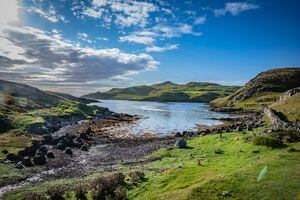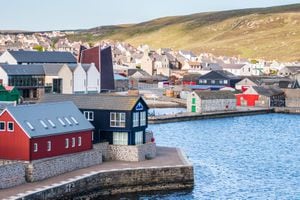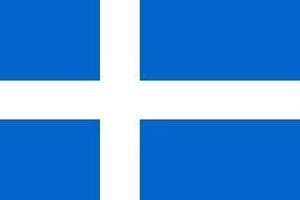Island Games: Get to know ... Shetland
WHAT do Inverness and Aberdeen in Scotland, Bergen in Norway and Torshavn in the Faroe Islands have in common?

They are all about 220 miles away from Lerwick in Shetland.
This equidistance is reflected in Shetland’s history and in its flag.
‘Up until 1469, Shetland was Norwegian, so that’s a big part of our heritage and culture,’ said Shetland Island Games Association secretary and general team manager Bob Kerr.
‘We have a Viking fire festival that runs from January to March that celebrates this – called Up Helly Aa – so it’s still a part of our self-identity.’
The current Shetland flag only became official in 2005 – after decades of representation by Shetlanders to the relevant Scottish officer of state – and combines the exact colours of Scotland’s saltire with the dimensions of the Nordic cross that we see on the flags of Aland, the Faroe Islands, Hitra and Orkney, as well as Denmark, Sweden, Iceland, Finland and Norway.
Asked to describe the Shetlanders themselves, Bob considers the northerly latitude to be a factor in shaping their character.
‘We’re a hardy bunch up here,’ he said.
‘We have lots of very dark winters and we have to be resilient. We do get a lot of weather.’
That Shetlanders do a lot of fishing should come as no surprise, given their position, but the extent of the industry is extraordinary.
‘There’s more fish landed in Shetland each year than in all the ports of England, Wales and Northern Ireland put together,’ Bob said.
‘We have some of the UK’s biggest pelagic trawlers and we get huge catches of mackerel, haddock, cod and herring, as well as farming salmon and mussels.
'About two-thirds of Scotland’s mussels are grown in Shetland.’
But Shetland is no one-trick pony, Bob said, also being ‘the heart of the North Sea oil industry’.
‘And we’ve branched out into wind and tidal energy and hydrogen production, along with carbon capture and storage.'

The Viking Wind Farm project is intended to consist of 103 turbines – each up to 155 metres in height – producing 4.3MW, which would be enough to power half a million homes.
Tourism is also booming, with 100 cruise ship visits a year to Lerwick, and this year also saw the visit of more traditional vessels, with the capital included in the route of the Tall Ships Race.
When asked what Shetlanders love to moan about, Bob gives an answer that has become very familiar during the Get To Know The Islands series.
‘Transport – in particular the ferry fleet,’ he said. ‘We don’t have tunnels, like they do in the Faroes.’
Internet connectivity has also been an issue.
‘On one day last year, the cables north and south were broken and so the islands had zero communications. It was quite unnerving. There were no contactless payments, no social media and no email,’ Bob said.
And then, after a pause, he added ‘actually it was quite liberating’.
When it comes to sport, Shetland, like Guernsey, always has a clearly identifiable rival to go up against.
‘That would be the neighbours,’ said Bob.
‘We call these matches against Orkney in a range of sports “the Inter-Counties” but we also have something called the “Junior Inter-Counties”, which has been going since 1947.’
This competition sees under-18s compete in football, athletics, hockey, swimming and netball, with every single competitor earning points for their own archipelago.
‘It’s always a close-run thing and honours have been fairly even over the years,’ Bob said.
In this year’s edition of the event, Orkney won the coveted Stuart Cup by 159 points to 155.5.
However, Bob is clear that it’s the Island Games that defines sporting ambition in Shetland.
‘It’s massive,’ he said. ‘It’s the peak of a two-year sporting cycle for hundreds of hopeful competitors. It’s a wonderful opportunity and we’re proud and excited to take part.’
Shetland has hosted the Island Games only once, in 2005. So, is it about time it was given another shot?
‘There are rumours that we’d like to bid again,’ said Bob, ‘but some of us can still remember the amount of work it took last time, so we’re OK with waiting a while longer.’
About Shetland

Area: 1,466 sq. km (566 sq. miles)
Population: 22,920 (2019 census)
Population density: 16 per sq. km
Time zone: Same as Guernsey
Distance from Guernsey: 1,180km (733m)
Total IG medals won: 251 (62 G, 80 S, 109 B)
Medals won in 2003: 16 (4 G, 3 S, 9 B)
Competitors coming to Guernsey: 88
Route: Overnight ferry to Aberdeen, charter flight to Guernsey with Aurigny (but some are driving from Aberdeen to the Poole ferry with equipment)
Sports in which competing: archery, athletics, badminton, cycling, golf, football, sailing, swimming, table tennis, triathlon
Biggest sports star: Andrea Strachan (swimming)
National delicacy: Reestit mutton (lamb soaked in brine then dried over a peat fire until solid), often made into a soup with tatties (potatoes) and served with bannocks (flatbreads)
Parliamentary representation: One MP in the 650-seat House of Commons – chosen with Orkney – one MSP in the 129-seat Scottish Parliament, Shetland Islands Council has 23 members
